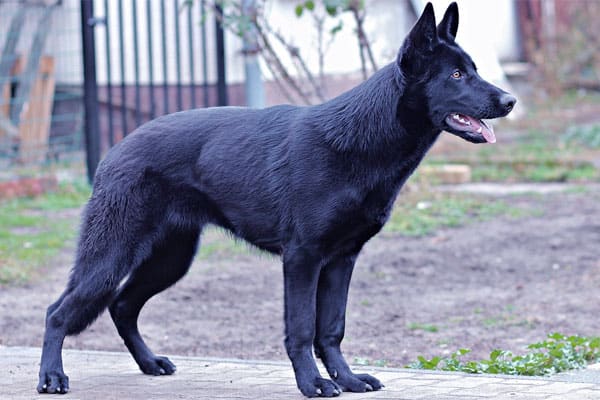Lycan Shepherd: Learn All About This New Emerging Shepherd Dog Breed
The Lycan Shepherd dog is a brand new breed in development that has been turning heads due to its gorgeous wolf-like appearance.
What is a Lycan Shepherd?
Lycan Shepherds are an emerging breed being developed by combining Blue Bay Shepherds, working-line German Shepherds, and Belgian Malinois.
The objective is to create dogs with superior intelligence levels, a wolf-like appearance, and reliable temperaments.
In this article, we bring you up to speed on what is known about the Lycan Shepherd dog breed, including approximate shape, size, temperament, coat, training needs, health issues, and suitability for a home where kids and other pets may be present.
So now read on to learn all about the Lycan Shepherd dog breed!
What Is A Lycan Shepherd?
The Lycan Shepherd is named for the breed’s similarity to a Lycanthrope.
A Lycanthrope is a human with the ability to transform themselves either into a full-on wolf or into a being who has traits that are wolf-like.
This breed is in the very early stages of its development and combines Blue Bay Shepherds, German Shepherds, and Belgian Malinois.
As a result, we can expect to see each individual parent dog’s traits coming out in the puppies.
While the creator of the breed certainly does an amazing job with his pups, unpredictable behaviors are definitely possible.
Since the Blue Bay Shepherd has wolf dog genetics, these dogs could potentially have some unpleasant temperament issues without the proper upbringing and training.
This is not an ideal dog for first-time dog owners.
The creator of Blue Bay Shepherds has shifted their focus to removing aggression.
But as they are still bred with German Shepherds and Belgian Malinois to form the Lycan Shepherd, the risk of aggressive behavior still exists.
But for those who want a dog that will be an effective and loyal protector of the home, and is less worried about temperamental issues, this could be the perfect dog.
| Breed | Temperament | Coat | Training | Health | Suitability For Families | Size | Price |
|---|---|---|---|---|---|---|---|
| Lycan Shepherd | Great work ethic, trustworthy nature, even tempered | Dark, thick, double coat that sheds seasonally and year-round | Larger brain-to-body size, very trainable, highly intelligent | F1 breeds are generally healthier, genetic diversity improves overall health | Not ideal for first-time dog owners, needs a highly active owner | 55-80 lbs, 22-25 inches tall | $3,000-$5,000 |
Why Isn’t the Lycan Shepherd Dog Recognized and Registered Yet?
In the United States, the American Kennel Club (AKC) is the official purebred dog breed registration oversight organization.
The AKC has very strict guidelines and standards for what a new dog breed must do in order to receive recognition and registration as an AKC purebred dog.
There are several tiers that any new proposed dog breed must move through.
As well, the breed history must have at least 40 years’ worth of documentation and pedigrees before the AKC will even consider recognizing the new breed and opening up registrations for breeders and owners.
The Lycan Shepherd has a long way to go before this new hybrid dog breed will have amassed the required data and documentation, not to mention lineage and sheer numbers, to qualify as an AKC-registered purebred dog breed.
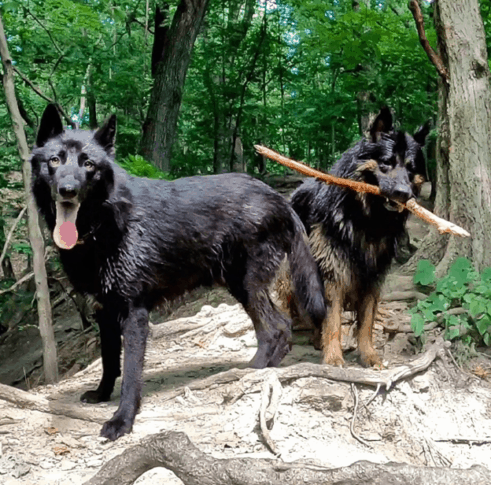
photo: https://www.instagram.com/1st508th_airborne/
Lycan Shepherd Versus Blue Bay Shepherd
There are more than a few different shepherd dog breeds under development at the moment.
Some look quite similar – enough to make for some confusion when trying to sort out which dog you are admiring.
The Blue Bay Shepherd is perhaps the best-known new shepherd dog breed that is just entering the developmental phase.
As with the Lycan Shepherd, there is really only one dog breeder that is working seriously at the moment to establish the new breed and stabilize the characteristics into an early stage breed standard.
For the Blue Bay Shepherd, the dog itself takes the breed name from Palm Bay, Florida, where the breeder is located.
For the Lycan Shepherd, as we mentioned here earlier, the proposed breed name references a dog with human-like and also wolf-like qualities.
As with the King Shepherds and the Shiloh Shepherds, two other shepherd-type dog breeds in development, the Blue Bay and Lycan dog breeders appear to be incorporating the iconic German Shepherd dog breed line into their new breeds-in-development.
Because the Blue Bay Shepherd and the Lycan Shepherd are the two newest shepherd-type dog breeds in development, these are the two-hybrid dog breeds that are most frequently confused with each other.
How Did the Lycan Shepherd Dog Begin?
The Lycan Shepherd dog is part of the Lycan Shepherd Project, which was founded by an experienced animal warden and dog breeder who also breeds bulldogs.
The dogs are designed to display certain desirable appearance and temperament traits as outlined by the breeder.
Larger brain-to-body size
The goal is to develop a canine with superior intellect, especially with respect to their ability to solve problems.
As the breeder points out, the wolf has a larger brain-to-body ratio than the modern domestic dog.
Leggy, rangy wolf-like appearance
The lithe, lean body type and long legs of the wolf is a desirable appearance traits in the Lycan Shepherd. This body type is also associated with a high level of athletic ability.
Great work ethic
The addition of the German Shepherd dog breed line ensures the Lycan Shepherd dog breed will inherit the solid work ethic and trustworthy nature of the GSD and Malinois breeds.
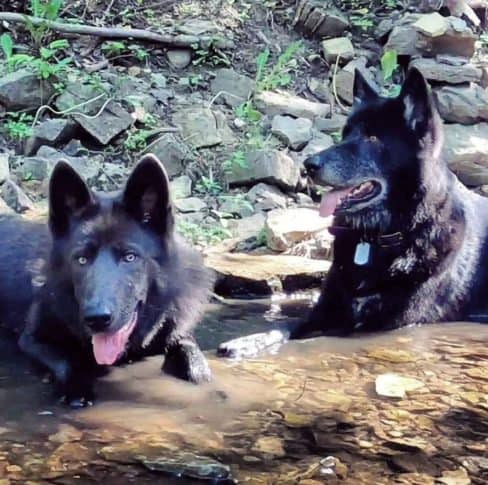
photo: https://www.instagram.com/1st508th_airborne/
Three Dog Breeds That Form the New Lycan Shepherd
The Lycan Shepherd breeder explains that there are three main dog breeds that he is using to create the new Lycan dog breed.
Those three breeds are as follows:
So let’s take a closer look at each of these dog breeds to get a better sense of what to expect if you decide to add a Lycan Shepherd dog to your family when that option becomes available.
Working Line German Shepherd Dog Breed
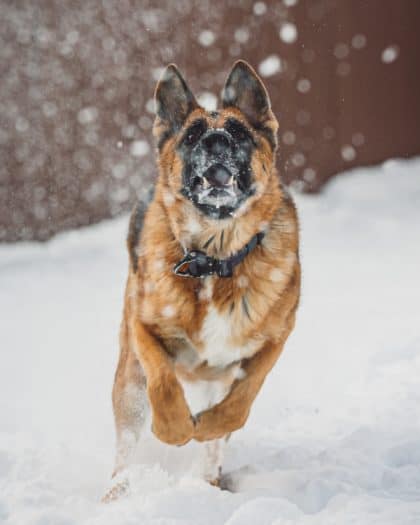
According to the American Kennel Club (AKC), the German Shepherd dog breed is the second most popular companion canine in the United States, outranking 194 other purebred dog breeds to gain this honor.
But while many people know the German Shepherd dog breed at least by sight, what most people don’t realize is that there are two different GSD breed lines: a show dog line and a working dog line.
The Lycan Shepherd dog breeder is specifically using the working dog GSD line to help develop the new Lycan dog breed.
The working dog GSD line is bred primarily for temperament and personality traits – for work ethic, intelligence, problem-solving abilities, trustworthiness, and similar characteristics – rather than towards a strict appearance standard.
This produces dogs that are purebred but show greater variance in the way that they look.
This also typically produces dogs that are stronger and more sound in terms of health because there is more genetic diversity permitted in the breed line.
On average, the German Shepherd purebred dog breed weighs between 50 and 90 pounds and stands 22 to 26 inches tall, with males outweighing females by about 15 pounds and standing on average about two inches taller.
This dog’s overall life expectancy is seven to 10 years.
German Shepherd dogs are extremely loyal and people-centric. They have very high prey drive, chase drive, guarding and protection instincts, herding instincts, and energy levels.
With strangers, the German Shepherd is typically aloof, but with “their” people this dog is extremely affectionate, loving, and vocal.
German Shepherds are a top pick for K-9, police, military, and private security and protection work. GSDs also make great service dogs and are excellent canine athletes.
Belgian Malinois Dog Breed
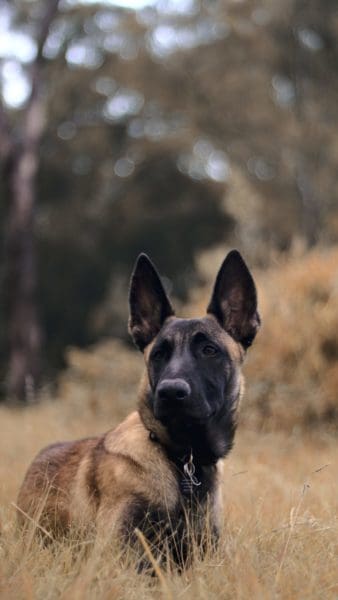
The Belgian Malinois is sometimes confused with the German Shepherd dog. In truth, the two do look somewhat alike and are both favorite breeds for K-9 work.
However, according to the American Kennel Club (AKC), the Belgian Malinois is far less well known overall than the German Shepherd, ranking 46th out of 196 dog breeds in terms of popularity as a companion canine.
The Belgian Malinois weighs between 40 and 80 pounds and stands 22 to 26 inches tall, with males outweighing females by up to 20 pounds and standing about two inches taller.
They have very long legs and slim bodies and are amazing athletes.
The Belgian Malinois has an unusually long lifespan for a medium to large breed dog. These dogs can live 14 to 16 years.
The Belgian Malinois comes from the herding dog group and inherits a very strong chase drive and prey drive.
They are bred to work long, hard hours herding livestock, guarding, protecting, and serving animals and people.
Like the German Shepherd dog, the Belgian Malinois is generally aloof and guarded with strangers and very loving and devoted to “their” people.
Blue Bay Shepherd Dog Breed
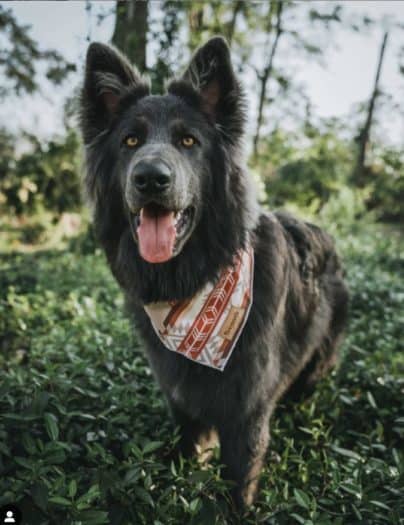
The Blue Bay Shepherd, like the Lycan Shepherd, is really in development only by one dedicated breeder, at least at the time of publication of this article.
The breeder’s operation is called Southern Bay Ranch in Florida.
The Blue Bay Shepherd has an unusual blue-black color and the breeder’s stated goal is to create a shepherd-type dog with a wolf-like appearance.
So here, the breeder is really focused on breeding to a certain desired appearance standard and developing a breed line based on the conformation (appearance) of the dog as well as an emphasis on a gentle, loyal temperament with no aggression issues.
Because the ultimate goal is a domestic dog with a wolf-like (lupine) appearance, the breeder began with both wolf-dog and domestic dog foundation animals (parent dogs).
The breeder states that they have used European German Shepherd dogs as well as wolf dogs.
As of the time of publication of this article, the breeder states that they are entering their sixth year of hybrid generational breeding and that they are hand-issuing signed pedigree certificates and each puppy has a unique number.
How Can Hybrid Breeding Help Strengthen a New Purebred Breed Line?
As you just read, whenever there is a strong emphasis on breeding for certain specific traits, especially appearance traits, this can narrow the genetics of the breed line.
Over time, with less genetic diversity, undesirable genes can be passed down along with desirable genes.
This is important to know because, with as much as people now know about the canine genome, there is still just as much left to learn.
Breeding for certain appearance traits can be complicated when the gene combination that produces a certain eye or coat color or a specific coat type may be linked to health weaknesses.
The breeder doesn’t always know this until the health issues show up later on in the breed line.
This is why hybrid breeding can be desirable for the future of the dog breed, as the Journal of Canine Genetics and Epidemiology points out.
Hybrid breeding, where two or more purebred dog breeds are crossed to produce a totally new dog breed, can reintroduce more genetic diversity and thus reduce the incidence of genetic health issues.
Using the example of the Lycan Shepherd, for instance, we now know there are three different dog breeds involved in shaping the new breed – two purebreds and one another hybrid in development.
The best place to start when trying to identify and remove health concerns from the new hybrid breed line is with the Canine Health Information Center (CHIC) database.
This database keeps a record of known genetic health issues for each parent dog breed.
The German Shepherd has a huge list of genetic health issues: hip dysplasia, elbow dysplasia, eye issues, cardiac issues, degenerative myelopathy, autoimmune thyroiditis, and temperament.
As well, the GSD has an unusually brief life expectancy.
The Belgian Malinois has three main genetic health concerns: elbow dysplasia, hip dysplasia, and eye issues. Malinois has an unusually long life expectancy, however.
So already it is easy to see how crossing the German Shepherd and Belgian Malinois lines might add much-needed genetic diversity to the GSD line in the interests of an enhanced life expectancy and reduced health issues.
Adding in the in-development Blue Bay Shepherd, with this new hybrid’s wolf-dog influence, expands the genetic diversity in the Lycan Shepherd dog line even further and introduces desirable temperament traits that have gotten watered down in GSDs.
Clearly, creating a whole new dog breed is often a labor of love and can be a lifelong project.
The breeder often starts with nothing more than an idea or a vision of what might be possible with strategic breeding and careful genetic study.
It will be interesting to follow the development of the Lycan Shepherd!
Frequently Asked Questions
How much does a Lycan shepherd cost?
Ok, we’re going to level with you here. Lycan Shepherd puppies are very expensive to buy. You can expect to pay at least three thousand dollars for a Lycan Shepherd puppy at the bare minimum.
And at the higher end, you can expect to pay as much as a whopping five thousand dollars.
That said however, other rare breeds can often cost just as much, at least at the three thousand dollar mark, so from that perspective it’s perhaps not as expensive as it might be.
The precise cost of a Lycan shepherd depends on a number of different factors, such as the geography, the age of the dog, what generation of breeding it comes from, and so on.
When you are shopping for a Lycan Shepherd it is important that you ascertain the puppy’s parentage, in order to determine whether it is a real Lycan Shepherd because you do hear of stories where people are sold fake Lycan shepherds.
Are Lycan shepherds good pets?
As far as we’re concerned, Lycan Shepherds make for excellent pets. They generally have a very nice temperament and they can take to training very easily.
The Lycan Shepherd is meant to have the same brain to body ratio as a wolf, and it is commonly thought that this should give them greater intelligence and better problem solving skills.
And this really sells them as a pet, because it means they can play all sorts of games.
They are playful and energetic, which means that they are well suited to more active families. They need to be kept well occupied as much as possible, and they need to have very frequent and energetic exercise.
However, it’s important to note at this point that Lycan shepherds are not a recommended breed for beginner dog careers.
This is because they require quite a lot of training, escape proofing, and socialization.
For these reasons, we would recommend this breed for younger and more active families, rather than for families and individuals who aren’t particularly active and aren’t as available to spend quality time with the dog.
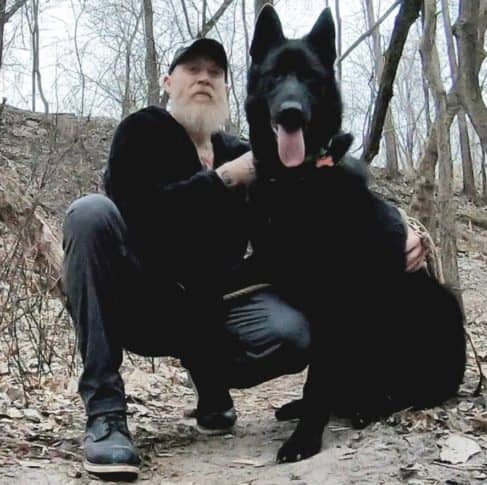
Do Lycan Shepherds shed?
Lycan Shepherds tend to have a very dark, thick, double coat, usually (but not always) black.
All the breeds that the Lycan Shepherd is based on, namely the Blue Bay Shepherds, working-line German Shepherds, and Belgian Malinois, are all breeds that shed quite a lot.
So, as you might expect, yes Lycan Shepherds do shed their fur and this can certainly occur seasonally, but can also be constant as well rather than just seasonal.
Moreover, the coat of a Lycan Shepherd is not usually hypoallergenic, so it’s not a recommended breed for those with dog fur allergies.
As such, if you are looking after a Lycan Shepherd, we strongly recommend that you brush their coat at least 2 or 3 times every week.
You should also bathe the Lycan Shepherd’s fur with a mild dog-friendly shampoo every three to four months.
What is an F1 Lycan Shepherd?
In dog breeding, the “F” in F1 stands for “filial” and is a simple and straightforward way to denote the generation of a dog.
F1 stands for 1st generation, F2 stands for 2nd generation, F3 stands for 3rd generation, and so on.
The maternal and paternal parents of an F1 Lycan Shepherd can include any two of Blue Bay shepherds, working-line German shepherds, and Belgian Malinois.
And the parents of an F2 Lycan Shepherd will include an F1 Lycan Shepherd, either another Lycan Shepherd or a Blue Bay Shepherd, working-line German Shepherd, or a Belgian Malinois
F1 breeds are less likely to have any of the typical health issues that you can get with later generation pure breeds.
How big do Lycan Shepherds get?
When you buy a puppy of any breed it can be hard to imagine them as a bigger dog before they’ve had any real chance to grow, but it does happen.
When you buy a puppy they are very small and cute and easy to carry around. You could even carry them one-handed if you wanted to.
But, when a Lycan Shepherd is full grown, it can weigh anywhere between 55 and 80 pounds.
And as for height, it can reach heights of 22 to 25 inches tall. So they’re not too big and heavy, and you may still be able to pick them up from time to time if you need to.
Meet Two Generations of Lycan Shepherd Dogs
In this owner-made YouTube video, you can meet a Lycan Shepherd dog puppy and his dad.
While Lycan Shepherd dogs are hard to come by at the moment, there is demand and interest and that is typically what drives a breed’s development and official registration.
























